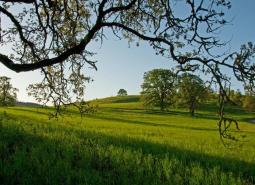Cooperation between landowners, non-profit organizations, and state and federal agencies that began decades ago resulted in a remarkable feat: in 2014, the Oregon chub was the first fish to be taken off the Endangered Species List since the Endangered Species Act (ESA) was enacted 40 years ago.
Photo Credit: Dave Herasimtschuk, Freshwater Illustrated. ODFW biologists sample for Oregon Chub.
When Oregon chub were listed in 1993 as “endangered” under the ESA, the population had declined to under 1,000 fish in eight known locations, down from at least 29 locations historically. These silvery, speckled minnows live in sloughs, bogs, beaver ponds, and other slow-moving backwaters of the Willamette Valley. Many of these habitats were destroyed over the last 100 years by dam construction, stream channelization, and wetland draining.
The listing triggered a multi-agency campaign to recover the Oregon Chub population. The 22-years-long recovery program included better monitoring, working with landowners to secure new habitat, improving floodplain management, and transplanting fish to more than 20 new locations.
Landowner cooperation was key to the campaign’s success. Many landowners were at first wary of introducing an endangered species on their property but became enthusiastic partners as they learned more about Oregon chub and the “Safe Harbor Agreements” available under the ESA. These agreements assure landowners they will not be required to undertake management activities beyond those specified in the agreement.
Recovery was also due to efforts of the Oregon Chub Working Group. Formed in 1992, the group included representatives from the U.S. Fish and Wildlife Service, ODFW, U.S. Army Corps of Engineers, the U.S. Forest Service, Oregon State Parks, Oregon State University, the McKenzie River Trust, and Grand Ronde Tribe.
When the Oregon Chub Working Group met in 2012 to review the numbers, they concluded the populations were large, stable, and dispersed enough to warrant a closer look at delisting the fish. A follow-up review of the numbers in 2013 confirmed their earlier finding – the populations had grown to approximately 160,000 fish in 83 locations.
Under the criteria set in the Oregon Chub Recovery Plan, there needed to be at least 20 populations of at least 500 adults, with each population stable or increasing in abundance for seven years. In addition, these populations needed to be dispersed with at least four populations each in three Oregon river basins – the Middle Fork Willamette, Santiam, and mainstem Willamette.
The criteria were met, and an inconspicuous minnow had the distinction of being the first fish removed from the Endangered Species List proving once again, that Oregonians continue to carry on a history of conservation leadership.


